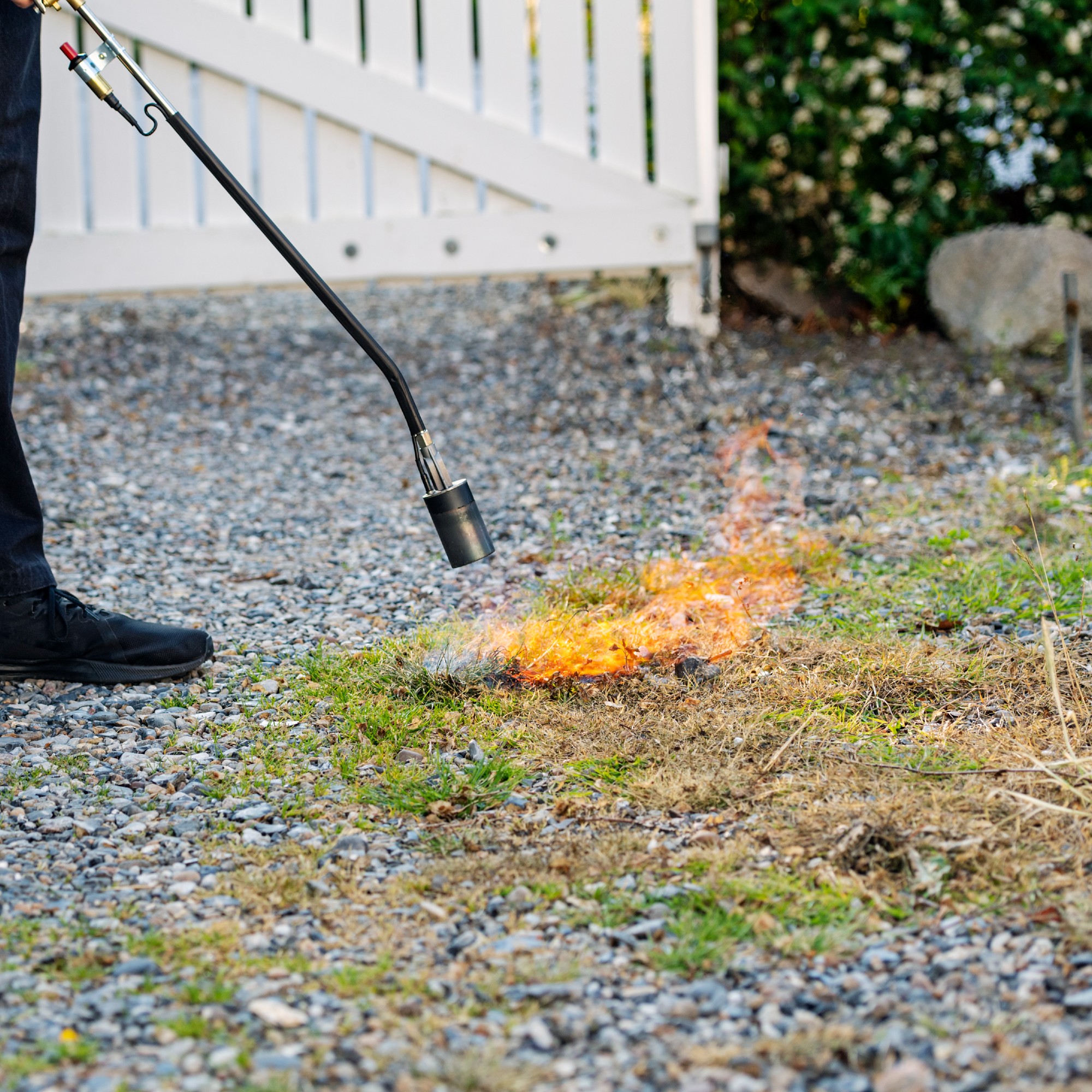How does flame weeding work? Experts share how effective getting rid of weeds with fire is and whether it’s safe to do
Should you be using fire to rid your garden of weeds?


Before you get too excited or scared, flame weeding is not about lighting a match and setting fire to your garden or patio weeds. So please don’t do that!
But it is an effective method how to kill weeds using the power of fire with the help of a specialised tool, also known as a weed burner. And it is slowly becoming a mainstream one as even the likes of Aldi are releasing weed burners for as little as £19.99, while Amazon has sold several hundreds of its bestselling weed burners in the last month with prices starting at £16. So don’t worry, it’s not an expensive way of getting rid of weeds.
But whenever fire is involved, one must proceed with caution. Which is why we’ve consulted our gardening experts to see how safe flame weeding actually is, as well as effective. And whether this is the best way to get rid of weeds in our outdoor spaces that we’ve been sleeping on.

How does flame weeding work?
Firstly, there are two types of weed burners you can use to flame weed. ‘Flame weeding uses a device that can be powered by butane gas or electricity to generate either a flame or very hot air,’ says Fiona Jenkins, gardening expert at MyJobQuote.co.uk. ‘By passing a flame or burst of hot air over the weeds you can effectively destroy them without using chemicals.’
So you can choose which type you prefer – gas or electricity-powered one. One thing to note is that this method is best used on patios rather than to get rid of weeds in a lawn as you could torch your lawn by accident, too.

Fiona Jenkins is a UK-based landscaper with over twenty five years of experience in the industry. As a gardening expert for MyJobQuote, one of the UK's top trades-matching sites, Fiona offers her expert advice to MyJobQuote's tradespeople and homeowners, and has also been featured as a gardening expert for a range of reputable publications.

Perhaps surprisingly enough, experts recommend this method over some others like using bleach to kill weeds or weed killer as it is less harmful to the environment.
‘Flame weeding is as effective as traditional herbicide and mechanical weeding methods,’ says Petar Ivanov, Fantastic Gardeners' gardening expert. ‘Aside from the fact that it can even be more effective than these other methods of weed control, it also offers several additional advantages, the most important of which is that it is less harmful to the environment.’
Fiona adds, ‘It is particularly good for people who cannot bend down to pull up weeds or for those who have organic gardens and don’t wish to use chemicals. Homes with pets and small children would also benefit from using a flame weeder rather than chemical weed killers to avoid accidental exposure.’

Petar Ivanov is one of the company's top-performing experts and manages over six teams of gardeners, delivering stunning landscape results and fostering a deep connection with nature through his work.

What you’ll need
- Weed burner
- Safety boots like these at Amazon
- Safety goggles like these ones from Amazon
- Safety gloves such as BBQ gloves like these from Amazon

Is flame weeding safe?
As previously mentioned, whenever there is fire involved, questions of safety and fire hazards are raised. So is flame weeding safe to do for the everyday gardener?
‘The weed burner is safe provided you follow the instructions and wear the correct personal protective equipment such as safety boots, gloves and goggles. The process itself is safe and as long as you only use the flame weeder as it is meant to be used there should be no issues with it,’ Fiona says.
But if it is your first time using it and you don’t feel confident, you can have a professional do it for you, at least for the first time around, Petar recommends.

One of the best-selling models on Amazon, this weed burner is perfect if you want to go for a gas-powered one. It even comes with four bottles of fuel.
FAQs
Will weeds come back if you burn them?
Eventually, the weeds should stop coming back. But first, you’ll need to repeat the process of flame weeding a few times.
‘Flame weeding is effective as the heat breaks down the cell structure of the plants and causes them to wilt. Within a couple of days, the weeds will have broken down and withered. A flame weeder will kill off the top part of the plant but not the roots. Weeds which have very deep roots will need to be treated regularly, usually about every three weeks during the growing season,’ Fiona says.
‘Eventually, with repeated treatments, the weeds will completely die off. Once the weeds have been burned, they will not be able to produce any seeds and spread. So over time, you will find that you have fewer weeds overall.’

How long does flame weeding last?
‘To kill weeds with a weed burner powered by gas, hold the weed burner 10 to 15 centimetres or six inches above the weed and pass the flame over it for a couple of seconds,’ Fiona explains. ‘There is no need to burn the weed completely up. The heat destroys the cell structure meaning the plant is not able to photosynthesize and will die. Burning the weed up completely is just a waste of fuel.
‘Electric weed burners work in much the same way except they produce very hot air to destroy the plant cells which kills off the weed. You need to hold the electric weed burner over the weed and lower it to about 5 millimetres for around 10 to 15 seconds in most cases.’
So as long as you follow instructions and take the necessary safety precautions, flame weeding could be a game changer for your efforts to get rid of weeds.
Get the Ideal Home Newsletter
Sign up to our newsletter for style and decor inspiration, house makeovers, project advice and more.

Sara Hesikova has been a Content Editor at Ideal Home since June 2024, starting at the title as a News Writer in July 2023. She is now also the Ideal Home Certified Expert in Training on Furniture, and so far has tested 80 different sofas.
Graduating from London College of Fashion with a bachelor’s degree in fashion journalism in 2016, she got her start in niche fashion and lifestyle magazines like Glass and Alvar as a writer and editor before making the leap into interiors, working with the likes of 91 Magazine and copywriting for luxury bed linen brand Yves Delorme among others.
-
 Should your front door colour match your hallway? Interior experts reveal 3 reasons why it should (and 3 reasons it shouldn't)
Should your front door colour match your hallway? Interior experts reveal 3 reasons why it should (and 3 reasons it shouldn't)Are you team matching or contrasting?
By Ellis Cochrane
-
 This £200 limited-time discount makes this Dyson vacuum cheaper than I’ve ever seen it - run don’t walk to Argos for this bargain
This £200 limited-time discount makes this Dyson vacuum cheaper than I’ve ever seen it - run don’t walk to Argos for this bargainIt's the most affordable Dyson on the market right now
By Lauren Bradbury
-
 Martin and Shirlie Kemp’s pastel flower beds has given their Victorian renovation a romantic look - how you can get the look
Martin and Shirlie Kemp’s pastel flower beds has given their Victorian renovation a romantic look - how you can get the lookTheir pastel garden is the cottage garden inspo you've been looking for
By Kezia Reynolds

